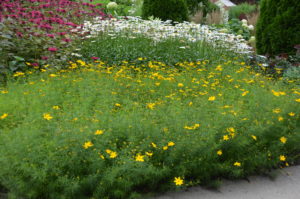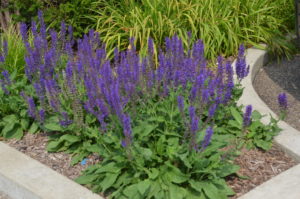If you are designing a new perennial garden, here are five proven perennials to start out with. All varieties are standout garden performers known for their long blooming period and showy flowers. Coreopsis and veronica are often utilized for edging along a sunny border. All can be planted in mixed containers.
‘Pow Wow Wild Berry’ coneflower (Echinacea purpurea ‘Pow Wow Wild Berry’) – is a distinctive cultivar of purple Coneflower. Plants form a midsized mound of coarse dark-green leaves, bearing large daisy flowers with magenta-pink petals surrounding an orange-brown central cone by midsummer. ‘Pow Wow White’ is a white flowering companion. 24 inches tall and 20 inches wide (Zones 3-9)
‘Zagreb’ Threadleaf coreopsis (Coreopsis verticillata ‘Zagreb’) – forms a spreading clump of very delicate, ferny foliage. This compact selection (12-18 inches tall and wide) bears loads of starry golden-yellow daisies, from early summer into the fall (Zones 4-9).
‘Becky’ Shasta daisy (Leucanthemum x superbum ‘Becky’) – Becky is a tall growing cultivar (36-42 inches high and 24 inches wide). Flowers are large single white daisies with a yellow eye, is excellent for cutting (Zones 4-9).
‘May Night’ Salvia (Salvia x sylvestris ‘Mainacht’) – is a medium grower (18-24 inches high and wide) with deep indigo blue flowers (Zones 3-9).
‘Royal Candles’ Spike Speedwell (Veronica spicata ‘Royal Candles’) – an outstanding upright growing speedwell with large, attractive deep-green glossy leaves and deep purple-blue flower spikes. Other veronicas available in deep purple, pink, and white; highly recommend dwarf pink flowering ‘Giles Van Hees’. Zones 4-8.
All five perennials listed here are easily to care for in full to partial sunlight (minimum 6 hours sunlight) and in average well-drained soils. Plants tolerate long dry periods after their first year in the garden. Expect 4-5 years of good flowering without the need of dividing plants. Deadheading flowers will extend blooming through the summer months. All tolerate summer heat and humidity. Flowers attract numerous bees, butterflies, and an occasional hummingbird.



 Posted in
Posted in 
